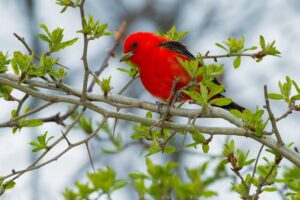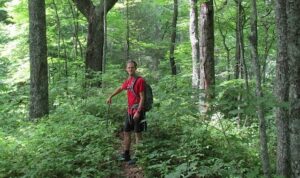It’s technological genius. It’s revolutionary. Its a game changer. It’s Merlin the bird identification app on my phone. Created by the ornithologists, the bird brains, of the Cornell University Ornithology Department, it’s a joy.
When it comes to learning bird calls, this app makes it, well, something I can actually accomplish. It represents a monumental step forward. Here’s how it works: When a particular bird song draws your attention you open the app, hold up the phone and Merlin listens in. Within seconds the app does its sorcery and provides the id and a whole lot more about the subject bird. If there are several birds calling in the immediate listening area the app distinguishes between them by highlighting the name of the bird calling at any particular moment. Did I tell you how amazing this is?
Birds are, in general, quite vocal, and their calls include ones for mating, feeding calls to young or a mate, predator warning calls, and territorial calls.
I’ve been interested in birds since I was a kid, and I got some official enlightenment on the subject in college as I was earning a degree in biology. But identifying birds by their calls, well, I never really got off the ground with that. And apparently I’m not alone. Think about how challenging it has been traditionally to learn the songs of birds.
Bird identification books -field guides- have been available for a couple of centuries. John J. Audubon made them household items and they’re wonderful. To describe birds’ voices, the field guides use phonetic transcriptions, and as my Audubon guide states, “the rendering of bird vocalization is, at best, variable.” And that’s when things can get muddied. “Duweep duweep” or “chachit chachit chachit.”
I mean what does that really sound like?
If one was exceptionally lucky a bird call expert could be a mentor, go out in the woods with you, listen for birds and say, “Hear that? That’s a weeble-bellied such and such.” And you’d dutifully absorb that knowledge. Or, more likely the bird expert would say, “Hear that one?” And you’d say,” which one?” And the teacher would say, “that one!” Of course, you typically can’t see the singing bird in question because it is obscured by all those leaves. “Hear that? That’s a Wood-Thrush. Got it? Well, that’s your lesson for today.”
So yeah it’s been historically tough to learn bird calls even under the best of circumstances.
Sure, you might get lucky and see a bird such as, say, a red wing blackbird perched on a fencepost plain as day, singing away and allowing for easy connection of voice to bird. More likely, however, the birds you’re listening to are, like I said, in the canopy obscured by multiple layers of foliage.
Well, you ask, haven’t recordings of bird voices been available for a long time? Yes. In fact, I remember my dad trying to learn a few calls by listening to a record album of them. Each call was identified by a man that sounded like Boris Karloff. I don’t think my dad was very successful in taking what he learned out into the field but I award him points for trying.
Merlin makes it easy to identify a bird based on its voice alone, as opposed to the call being a secondary or confirmational identification characteristic. Incredible.
The list of birds I’ve been listening to lately in the city of Roanoke and in the forests that surround us includes the Carolina Wren, Tufted Titmouse, Chaffinch, Indigo Bunting, Cardinal, Gray Catbird, Northern Flicker, Screech-Owl, Eastern Phoebe, Red-winged Blackbird, Mourning Dove, Blue-gray Gnatcatcher, American Goldfinch, Chimney Swift, Red-eyed Vireo, Ovenbird, Wood Thrush, Grosbeak, and Veery. And, as is the case with any similar study, the more I learn the more I notice.
My friend Dan and I were hiking recently in a remote section of Fort Lewis Mountain. It was a quiet mid-morning with just a slight rustle of foliage in the soft breeze. Gosh it was gorgeous. At one point I noticed a distinct and mellifluous call from the canopy of green above.
To Dan: “Whoa, hold on. Did you hear that? Listen. That. Right there.” We both stopped and stood with our heads cocked. Then we heard another one of the same; birds of a feather as they say. There was one on each side of us; we were transfixed in the delightful crossfire.
Quick-drawing my Merlin-equipped phone, I got an on-the-spot recording of the song and a positive ID. The verdict: Scarlet Tanager, one of my all-time favorites. Listening raptly, we peered in the direction of the call, bobbing our heads about as we squinted song-ward, trying mightily to catch sight of the Tanager closest to us.

“There she is, look right between those branches.” The fiery red orange of her feathers jumped out of the green.
Make my day.
My maternal grandfather was an enthusiastic birder. Even when infirmity in his old age kept him home bound he would sit in his favorite chair by a bay window and take great pleasure in studying the birds in his backyard. A field guide would be at the ready in his lap. As a teenager I took only a passing notice of his ornithological enthusiasm, but look at me now.
My granddad has been gone for decades now. Wouldn’t I love to reach across time and space and show him what I’ve learned? Whether by way of mentors, or field guides or state-of-the-art Merlin the idea is the same: the satisfaction -the excitement- of…
Discovery.
As I think about it, I can imagine not only the twinkle in my grandad’s eye but the gleam in my own as well.
-

Johnny R. on the Appalachian Trail. Johnny Robinson
